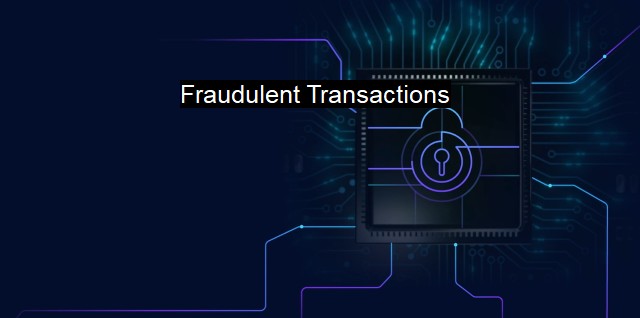What are Fraudulent Transactions?
Understanding and Preventing Fraudulent Transactions: A Guide for Cybersecurity and Antivirus Protection
Fraudulent transactions represent a subset of cybercrime activities which digitally deceive people or institutions, causing economic harm to them often for gaining financial advantage. In a broader sense, these transactions involve a person or entity deceitfully claiming something of value owned by another person with a malign intention. This act could be either committed directly by hackers or indirectly through altering the data in an entity's system to cause a fraudulent bank transfer. Combining sophisticated hacking methodologies and social engineering scams, cybercriminals regionally or globally target individuals, corporations, or governments.Understanding the concept of cybersecurity is crucial in interpreting the essence of fraudulent transactions. Cybersecurity, as it implies, signifies protective measures against digital crimes. The elephantine growth of digital networks in banking, governance, business, or even social relationships gives birth to the macabre potentiality of cyber threats including fraudulent transactions. Cybersecurity's fundamental amenities include protecting systems, networks, programs and data, from digital attacks.
While seeking a haven from physical filch or fraud, people hitherto have lean to the virtual world where a masked-faced ghost often called a cybercriminal commits act without any physical contact or directly assailable evidence, and such acts often comprehend fraudulent transactions. From conning an individual to give card details on a false pretext to illegitimately accessing an account to commit unauthorized transactions, these indeed form part of fraudulent transactions.
In another genre, corporate account takeover often impregnates fraudulent transactions in which criminals gain access to a business's financials to make illegal transactions. Beyond these, cybercriminals commit technologically astute scams known as phishing, malware, SQL injection and cross-site scripting to affect fraudulent transactions. Besides, they might reroute funds or temper institutions' data without their knowledge or cause an uncontrolled series of transactions leading to a severe economic crisis.
Widely inscribed in cybersecurity studies, antivirus software has a significant role in preventing fraudulent transactions. Serving as bodyguards for digital devices, antivirus software inspects, detects, and destroys harmful viruses or malware that hackers frequently harness to gain unauthorized access to user devices or networks. Similar to how a biological virus mutates and affects, computer viruses also change their forms and affect distinct parts of a computer. In some instances, they invade secure databases thereby gaining total control of systems to finally execute all types of fraudulent transactions.
The unique combination of signature-based detection, heuristic analysis, and behavioral blocking used by antivirus software helps defend against these multidimensional cyber threats. Signature-based detection prevents known threats using a database. the emerging threats need to be tackled with heuristic analysis detecting anomalies. behavioral blocking prevents any software or program from damaging the device or network once identified as a threat.
From individuals to multilateral corporations, everyone has a high stake in digital safety, for our dependency on the virtual world has grown more than ever before. Thereby, understanding various facets of cybersecurity, the implications of fraudulent transactions, and the subsequent role of antivirus in combating those threats acquires a monumental importance.
a fully secured cyber world still seems more of an illusion than a reality considering the technological advancements underway and the intricate loopholes that exist. So, cooperation between internationally recognized cybersecurity firms and governments, encryption of sensitive data, regular update of antivirus software, cybersecurity drills, and digital education can empower us. In turn, we can ensure a minimistically affected virtual terrain where occasional fraudulent transactions could occur but are rapidly detected, clamped down, databases are restored, culprits found and prosecuted ensures a satisfyingly safe digital existence.

Fraudulent Transactions FAQs
What is a fraudulent transaction in the context of cybersecurity?
A fraudulent transaction in the context of cybersecurity is an unauthorized financial transaction that is initiated by an attacker who has gained unauthorized access to a victim's financial account.What are some common types of fraudulent transactions that occur in the digital world?
Some common types of fraudulent transactions that occur in the digital world include phishing attacks, ransomware attacks, payment card skimming, and identity theft.What role do antivirus software and other security tools play in preventing fraudulent transactions?
Antivirus software and other security tools play a critical role in preventing fraudulent transactions by detecting and blocking malicious software and other threats that can enable attackers to gain access to victim's financial accounts. They can also help to identify suspicious behavior or patterns that could indicate a fraudulent transaction in progress.What should I do if I suspect that a fraudulent transaction has occurred on my financial account?
If you suspect that a fraudulent transaction has occurred on your financial account, you should contact your financial institution immediately to report the issue and take steps to secure your account. This may include changing your password, monitoring your account activity closely, and working with your financial institution to reverse any unauthorized transactions. You may also want to consider filing a report with law enforcement or other relevant authorities.| | A | | | B | | | C | | | D | | | E | | | F | | | G | | | H | | | I | | | J | | | K | | | L | | | M | |
| | N | | | O | | | P | | | Q | | | R | | | S | | | T | | | U | | | V | | | W | | | X | | | Y | | | Z | |
| | 1 | | | 2 | | | 3 | | | 4 | | | 7 | | | 8 | | |||||||